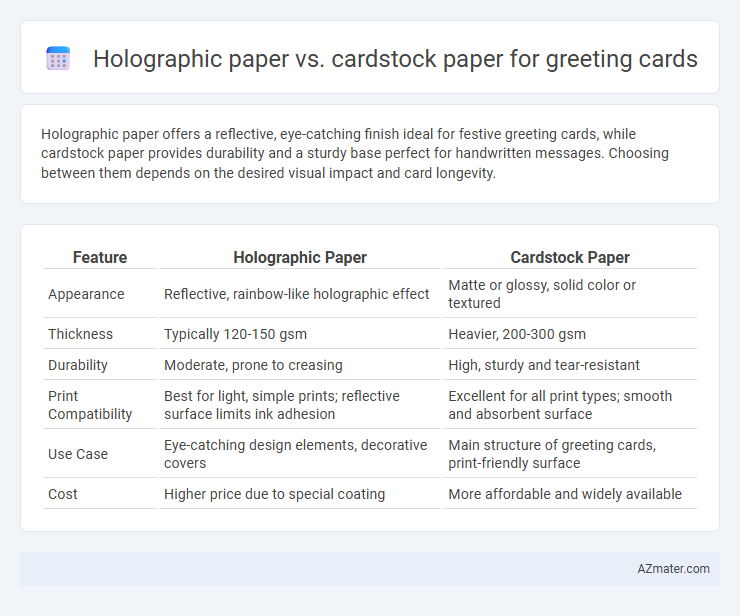Holographic paper offers a reflective, eye-catching finish ideal for festive greeting cards, while cardstock paper provides durability and a sturdy base perfect for handwritten messages. Choosing between them depends on the desired visual impact and card longevity.
Table of Comparison
| Feature | Holographic Paper | Cardstock Paper |
|---|---|---|
| Appearance | Reflective, rainbow-like holographic effect | Matte or glossy, solid color or textured |
| Thickness | Typically 120-150 gsm | Heavier, 200-300 gsm |
| Durability | Moderate, prone to creasing | High, sturdy and tear-resistant |
| Print Compatibility | Best for light, simple prints; reflective surface limits ink adhesion | Excellent for all print types; smooth and absorbent surface |
| Use Case | Eye-catching design elements, decorative covers | Main structure of greeting cards, print-friendly surface |
| Cost | Higher price due to special coating | More affordable and widely available |
Introduction to Greeting Card Materials
Greeting card materials vary significantly in texture and visual appeal, with holographic paper offering a shiny, reflective surface that enhances festive designs, while cardstock paper provides durability and a sturdy feel essential for high-quality cards. Holographic paper typically consists of a thin plastic laminate infused with light-refracting patterns, making it ideal for eye-catching, decorative cards. Cardstock, made from thick, pressed paper fibers, ensures structural integrity and ink absorption, making it the preferred choice for traditional greeting cards requiring longevity and ease of writing.
What is Holographic Paper?
Holographic paper is a specialty material featuring a reflective surface that creates a rainbow-like, shifting visual effect when exposed to light, making greeting cards visually striking and dynamic. Unlike cardstock paper, which is thicker and designed for durability and sturdiness, holographic paper emphasizes aesthetic appeal with its light-reflecting properties rather than structural strength. This makes holographic paper ideal for eye-catching embellishments and layered designs, whereas cardstock serves as the primary sturdy base for greeting cards.
What is Cardstock Paper?
Cardstock paper is a thick, durable material typically ranging from 50 to 110 lb weight, designed to provide sturdiness and a premium feel for greeting cards. Unlike holographic paper, which features reflective, eye-catching patterns, cardstock offers a smooth surface ideal for printing detailed designs and writing personal messages. Its versatility and firmness make cardstock the preferred choice for high-quality greeting cards that require easy folding and long-lasting structure.
Visual Appeal: Holographic Paper vs Cardstock
Holographic paper enhances greeting cards with vibrant, reflective surfaces that catch light and create dynamic, eye-catching patterns, making them ideal for festive or modern designs. Cardstock paper offers a sturdy, matte or glossy finish that provides a classic, elegant look, ensuring long-lasting durability and compatibility with various printing techniques. The choice between holographic paper and cardstock hinges on whether a shimmering, attention-grabbing effect or a traditional, solid visual appeal is desired.
Durability and Quality Comparison
Holographic paper offers a visually striking finish with reflective surfaces that enhance the aesthetic appeal of greeting cards, but it tends to be less durable due to its thinner composition and susceptibility to creasing. Cardstock paper provides superior durability and structural integrity, making it ideal for long-lasting greeting cards that withstand handling and storage without damage. The quality of cardstock also supports a wider range of printing techniques, ensuring vibrant colors and crisp details that maintain their appearance over time.
Printing Compatibility and Techniques
Holographic paper offers unique visual effects but requires compatible printing techniques such as UV printing or foil stamping to maintain its reflective quality without smudging. Cardstock paper is more versatile, supporting a wider range of printing methods including digital, offset, and letterpress, providing crisp, durable results. Choosing between the two depends on the desired print finish and equipment availability for optimal greeting card production.
Cost Differences Between Holographic and Cardstock
Holographic paper for greeting cards typically costs 30-50% more than standard cardstock due to its specialized manufacturing process and reflective surface. While cardstock offers affordability and ease of customization with prices averaging $0.10 to $0.50 per sheet, holographic paper ranges from $0.15 to $0.75 per sheet, impacting bulk purchasing budgets significantly. The cost difference influences design decisions, with holographic paper preferred for premium, eye-catching cards despite higher material expenses.
Environmental Impact and Sustainability
Holographic paper often contains a plastic coating that makes it difficult to recycle and contributes to environmental pollution, whereas cardstock paper is typically made from biodegradable materials and is more readily recyclable. Cardstock's sustainable sourcing from FSC-certified forests reduces deforestation and supports eco-friendly manufacturing processes. Choosing cardstock paper for greeting cards minimizes waste and lowers the carbon footprint compared to holographic paper, aligning with environmentally conscious practices.
Best Use Cases for Each Paper Type
Holographic paper is ideal for greeting cards requiring eye-catching, reflective designs that enhance visual appeal and create a festive, modern look, perfect for celebrations and special occasions. Cardstock paper provides durability and a sturdy feel, making it suitable for handmade cards, intricate cutouts, and designs requiring a professional, high-quality finish. Choose holographic paper for vibrant, attention-grabbing effects, while cardstock excels in stability and longevity for personalized greeting cards.
Final Verdict: Choosing the Right Paper for Your Greeting Cards
Holographic paper offers vibrant, eye-catching effects perfect for celebratory or festive greeting cards, enhancing visual appeal with reflective surfaces and dynamic color shifts. Cardstock paper provides durability and a professional look, ideal for formal or traditional cards that require sturdiness and ease of writing. Selecting between holographic and cardstock paper depends on the desired aesthetic impact and functional needs of your greeting card, balancing visual flair with structural integrity.

Infographic: Holographic paper vs Cardstock paper for Greeting card
 azmater.com
azmater.com